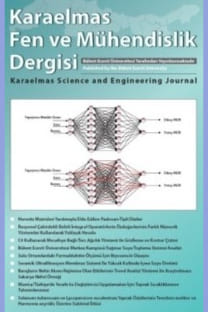Carbon mineralization of sewage sludge and fly ash
Carbon mineralization of sewage sludge and fly ash
Sewage sludge Fly ash, Carbon mineralization, Waste, Soil, Stabilization,
___
- Ahmad, R., Arshad, M., Naveed, M., Zahir, ZA., Sultan, T., Khalid, M. 2007. Carbon mineralization rate of composted and raw organic wastes and its implications on environment. Soil Environ., 26(1): 92-96
- Arslan, EI., İpek, U., Aslan, S., Öbek, E. 2009. Carbon mineralization of various composts in soil. Anadolu Univ. J. Sci. Tech., 10: 389-395.
- Baba, A., Kaya, A. 2004. Leaching Characteristics of Fly Ash from Thermal Power Plants of Soma and Tunçbilek, Turkey. Environ. Mon. Assess., 91: 1-3, 171-181.
- Baldock, JA., Nelson, PN. 2000. Soil organic matter. In Handbook of Soil Science, ed. M. E. Sumner, B25–B84. Boca Raton, Fl.: CRC Press.
- Bernal, MP., Sanchez-Monedero, MA., Paredes, C., Roig, A. 1998. Carbon mineralization from organic wastes at different composting stages during their incubation with soil. Agri. Ecosystems Environ., 69: 175-189.
- Bol, R., Bolger, T., Cully, R.,Little, D. 2003. Recalcitrant soil organic materials mineralize more efficiently at higher temperatures. J. Plant Nutr. Soil Sci. 166: 300-307.
- Campbell, CA., Biederbeck, VO., McConkey, BK., Curtin, D., Zentner, RP. 1999. Soil quality effect of tillage and fallow frequency: Soil organic matter quality as influenced by tillage and fallow frequency in a silt loam in
- southwestern Saskatchewan. Soil Biol. Biochem., 31: 1–7.
- Chiang, HL., Choa, CG., Chen, SY. 2003, The reuse of biosludge as an adsorbent from a petrochemical wastewater treatment plant, J. Air & Waste Manage. Assoc., 53: 1042-1051.
- Coûteaux, M., Bottner, MP., Berg, B. 1995. Litter decomposition, climate and litter quality. Trends Ecol. Evol. 10, 63-66.
- Doran, JW., Parkins, TB. 1994. Defining and assessing soil quality. In Defining soil quality for a sustainable environment, ed. J. W. Doran, D. C. Coleman, D. F. Bezdicek, and B. A. Stewart, 3–21. Madison, Wisc.: SSSA.
- FAO (Food and Agriculture Organization) www.fao.org/ docrep/T0551E/t0551e08.htm
- Flavel, TC., Murphy, DV. 2006. Carbon and nitrogen miner- alization rates after application of organic amendments to soil. J. Environ. Qual., 35: 183-193.
- Pando, M., Hwang, S., Guadalupe, Y., Reyes, A., Rossi, L., Ruiz, E. 2006. Possible applications for circulating fluidized bed coal combustion by-products from the Guayama AES Power Plant, Department of Civil
- Engineering and Surveying, University of Puerto Rico at Mayagüez, 100p.
- Pedra, F., Polo, A., Ribeiro, A., Domingues, H. 2007. Effects of municipal solid waste compost and sewage sludge on mineralization of soil organic matter. Soil Biol. Biochem., 39: 1375-1382.
- Singh, G. 2005. Environmental assessment of fly ash from some thermal power stations for reclamation of mined out areas, Fly ash utilization programme (FAUP), TIFAC, DST, New Delhi, India.
- Stoffella, PJ., Kahn, BA. 2001, Compost utilization in horticultural cropping systems. Lewis Publ., New York.
- Swift, M., Heal, OW., Anderson, JM. 1979. Decomposition in terrestrial ecosystems, Studies in Ecology 5. Blackwell Scientific Publications.
- Tisdall, JM., Oades, JM. 1982. Organic matter and water-stable aggregates in soils. J. Soil Sci., 33: 141-163.
- Topal, M., Arslan Topal, EI., Aslan S., Kılıç, M. 2011. Leachability of heavy metals from fly ash, slag of thermal power plant and
- treatment sludge. SAU Fen Bil. Derg., 15: 97-104.
- TSI, 2010. Turkish Statistical Institute, www.tuik.gov.tr.
- Wild, SR., Waterhouse, KS., McGrath, SP., Jones, KC. 1990. Organic contaminants in an agricultural soil with a known history of sewage sludge amendments:polynuclear aromatic hydrocarbons. Environ.Sci.Technol., 24: 1706-1711.
- Wolkowski, R.P. 2003, Nitrogen management considerations for land spreading municipal solid waste compost. J. Environ. Qual., 32: 1844-1850.
- Yang, LL., Zhang, FS., Mao, RZ., Ju, XT., Cai, XB., Lu, YH. 2008. Conversion of Natural Ecosystems to Cropland Increases the Soil Net Nitrogen Mineralization and Nitrification in Tibet. Pedosphere, 18: 699-706.
- Zhang, J., Wang, SL., Feng, ZW., Wang, QK. 2009. Carbon mineralization of soils from native evergreen broadleaf forest and three plantations in mid-subtropic China. Commun. Soil Sci. Plant Anal., 40:1964-1982.
- ISSN: 2146-4987
- Yayın Aralığı: 3
- Başlangıç: 2011
- Yayıncı: ZONGULDAK BÜLENT ECEVİT ÜNİVERSİTESİ
Carbon mineralization of sewage sludge and fly ash
E.ısıl Arslan TOPAL, Sibel ARSLAN, Murat TOPAL, Burçin YILDIZ, Oznur YUZGEC
